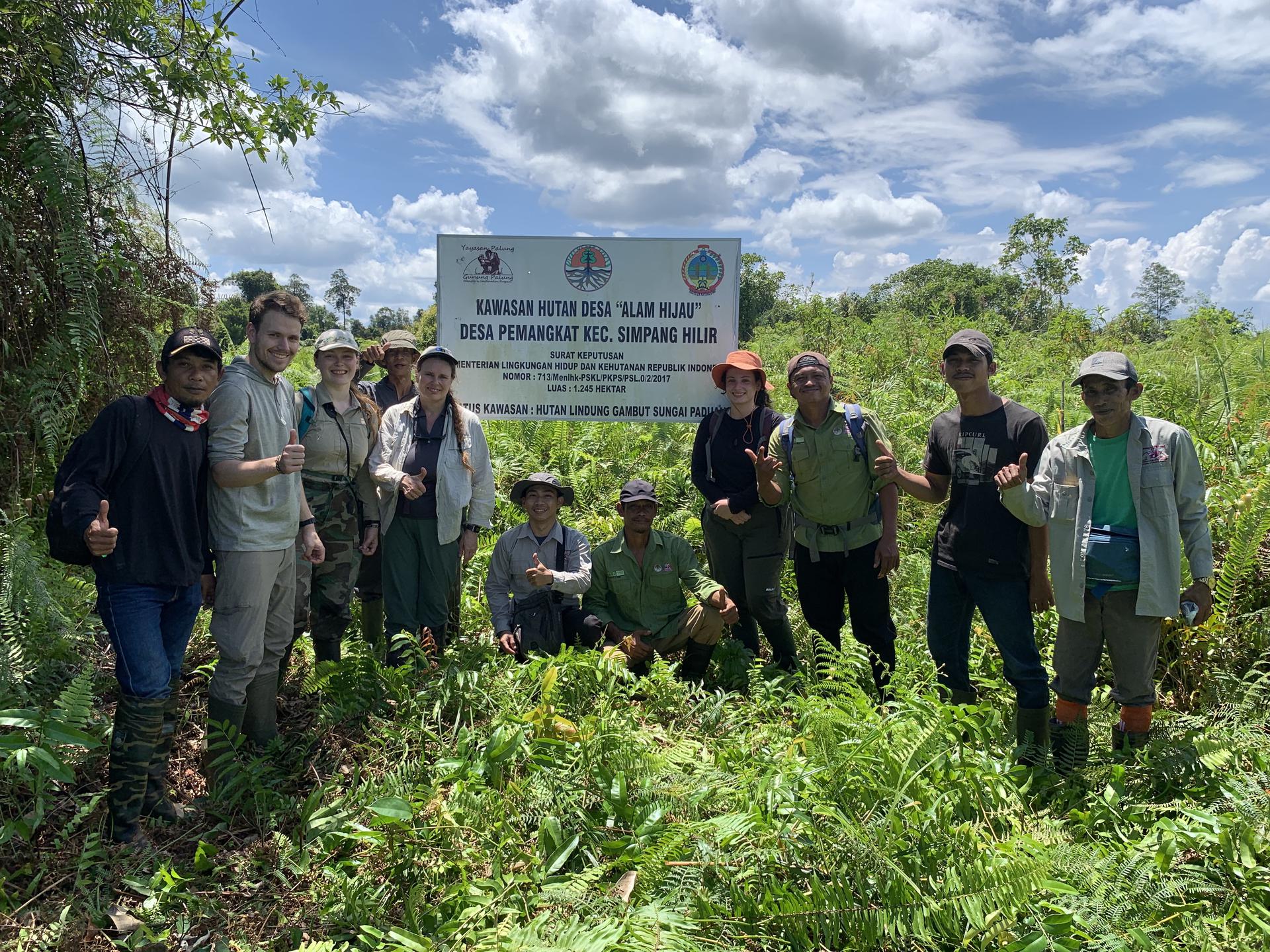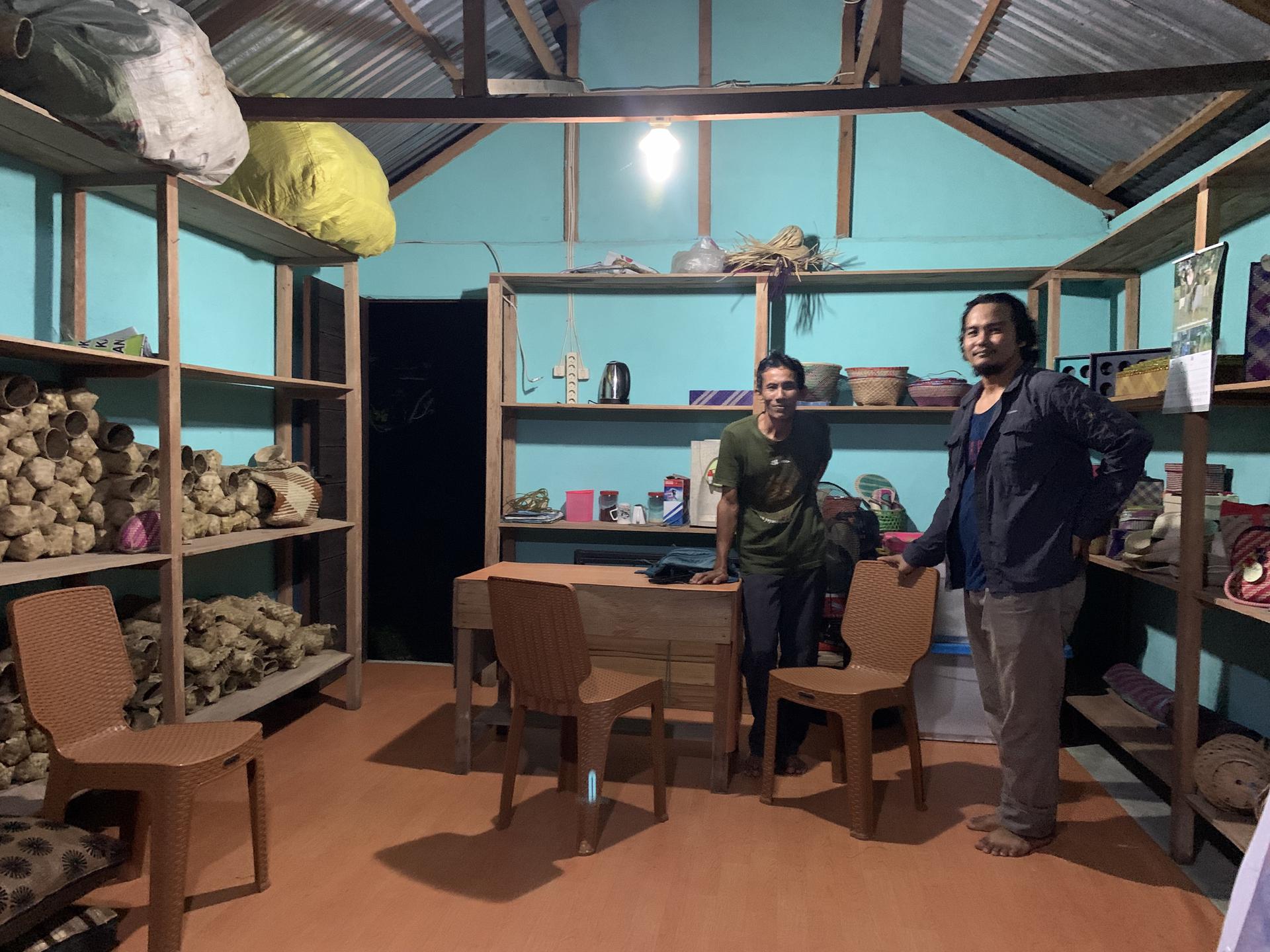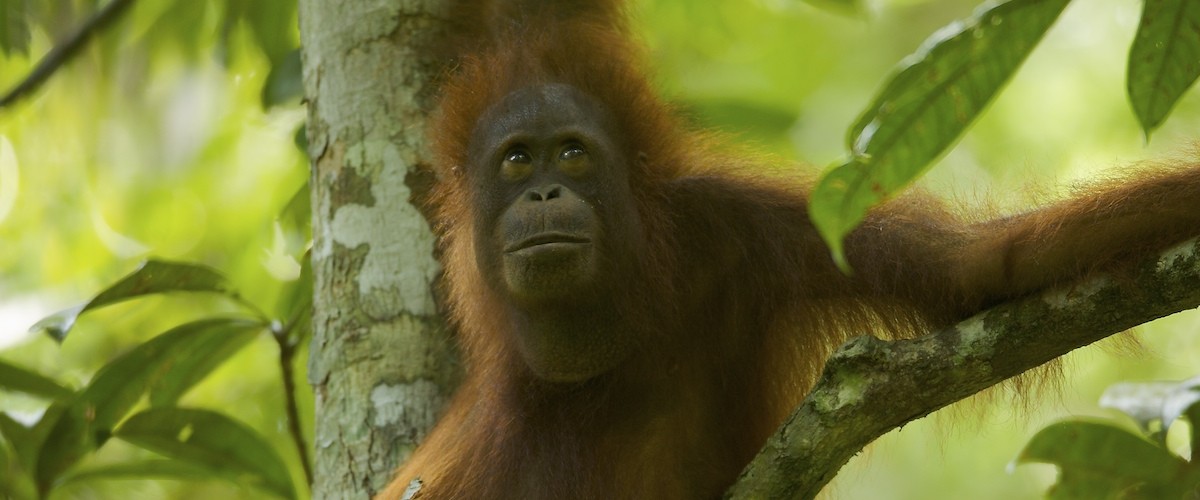By Cheryl Knott, Executive Director
A cacophony of Borneo’s distinctive sounds, from the singing duets of the gibbons to the high-pitched whir of late afternoon cicadas. The damp, earthy smell of the rainforest cycling through its rapid phases of decomposition and regeneration. The light penetrating through the top of the canopy, revealing the soft orange fur of a juvenile orangutan following his mom along giant tree branches in search of fruit one hundred feet up. These are some of the senses and scenes that filled my days this summer as I visited the Cabang Panti Research Station in Gunung Palung National Park, accompanied by my family, students, and team members. This was a milestone year – my first visit in 3 long years because of the global pandemic, and the 30th anniversary of my first trip to the site in 1992. It was also our first time seeing the newly rebuilt research station at Cabang Panti, as well as the new Rangkong River area camp, in person. We were truly amazed at this investment in the research station’s future and grateful to the National Park leadership and staff for their vision and allowing us to continue to be part of this most special of places.

Among the most followed orangutans this summer was the habituated mother-offspring duo of Bibi and Bayas. This has been one of the most researched pair of orangutans at the site over the last decade. During non-invasive focal follows, the team was able to test novel orangutan surveying methods, and implement new sampling and laboratory techniques. Stay tuned over the comings months as we share new observations with you through the voices of our team of students and scientists.

After spending several weeks at the research station, one of my main objectives of the summer was to visit some of the more remote areas surrounding GPNP where many of our most important conservation activities are being carried out by Yayasan Palung/GPOCP staff. As we prepared to leave the research station in mid-August, the river water level was high enough that we were able to take a small boat out of the forest, as opposed to walking out through the village – my first time in many years. Accompanying me was my daughter Jessica Laman, Program Coordinator Natalie Robinson and PhD students Zoe Albert and Frank Short, under the capable hands of boatmen Aceng (National Park Ranger) and Udin (Cabang Panti Camp Assistant). Traveling downriver in a small boat is a magical way to see the wildlife and botanical splendors that the Bornean rainforest harbors. We were not disappointed as we saw no less than 5 groups of proboscis monkeys and the silvered langur, rarely seen at this site. These are the types of sightings that we had 30 years ago – if we were lucky! After the scourge of forest fires and illegal logging in the 1990s that ravaged this river, it is so heartening to see these populations of proboscis monkeys thriving again. It is a tangible sign that the protection and conservation efforts that have targeted this region are paying off.

After a splendid trip downriver, we spent the night at our Bentangor Environmental Education Center in the village of Pampang Harapan. Almost the entire Yayasan Palung (YP) conservation staff was there to meet us and show us some of their projects. We headed out the next morning to the village of Pemangkat, in Simpang Hillir subdistrict, joined by YP Field Director Pak Edi Rahman, Customary Forest Coordinator Hendri Gunawan, Customary Forest Field Officer Robi Kasianus, and Sustainable Livelihoods Field Officer Pak Asbandi. We stopped first at the Pemangkat government office to pay our respects to the head of the village. After that we were off down a bumpy dirt road to the home of the Head of the Pemangkat Customary Forest Management Board (LPHD), Pak Hendra, to meet their SMART Patrol team. SMART (Spatial Monitoring and Reporting Tool) is a free software that enables local patrollers to track signs of both conservation threats and biodiversity.

The goal that day was to install a series of monitoring devices in the Customary Forest (Hutan Desa) Alam Hijau, Pemangkat to help the LPHD manage their forest. To get there, we rode motorbikes to the end of the small village road, then trekked an hour and a half into the forest, mostly along wooden planks previously used by illegal loggers. Once arriving at the first transect, we scouted out locations and installed two camera traps, one bioacoustic recorder, one temperature logger and one rain gauge. This will allow our project to passively monitor biodiversity and any illegal activity within the Hutan Desa. We saw many tree trunks bearing the claw scratch marks of Malayan sun bears and a plethora of pitcher plants – signs that this forest is an active home for endangered species. A recent SMART Patrol in the neighboring Hutan Desa of Nipah Kuning found a mother-infant pair of orangutans. Check out the video here. It’s exciting to see orangutans and other wildlife living safely in protected Hutan Desa, and motivates LPHD members to continue safeguarding these important community-managed forests.

Environmental education was GPOCP/YP’s first program and still forms an important part of our vision to foster a human community that is aware and motivated to conserve orangutans, their habitat, and biodiversity. Thus, the next day we were excited to have a chance to visit an elementary school in the town of Sukadana. After meeting with the school’s principal, we headed over to several joined classes of 5th graders to watch the YP Environmental Education Team in action as they performed a puppet show. We laughed along with the children at the antics of the mother orangutan, red leaf monkey, gibbon and hornbill as they answered the questions posed by the baby orangutan, “Pongo”. The children ended the day with a sing-along to Yayasan Palung’s original signature song Si Pongo.


After a meeting with the Environmental Education Team staff on the beach in Sukadana, we headed back to Bentangor for a weaving workshop. Artisans from the local district of Kayong Utara taught young children to weave tikar (mats) from Pandanus leaves as part of the “Goes to School” program. We also had our first peak into the newly rebuilt roadside gallery at Bentangor, selling the wide variety of handicrafts made by artisans that participate in our Sustainable Livelihoods program. We ended the day with a tour through our “mini forest” that showcases forest plants that are important sources for the non-timber forest products that form the basis of many of the Sustainable Livelihood artisans’ work.

Through our radio program we can bring our conservation message to thousands of local people. We were thus honored to join Sustainable Livelihoods Field Officer Abdul Samad as guests on the Kayong Utara Radio (Radio Lembaga Penyiaran Publik Lokal Radio Kayong Utara). The topic of the radio show was Nature Conservation Day (Hari Konservasi Alam Nasional), focusing on the theme “Restoring Nature to Build a Prosperous Society”. Samad, Natalie and I answered questions posed by the radio host about the mission and vision of Yayasan Palung. Through an engaging set of questions and answers, we talked about the various activities YP carries out to help nature and wildlife through initiatives that support and work with local communities.

Our next stop was to see Sustainable Livelihoods in action. Along with Samad and Sustainable Livelihoods Manager, Ranti Naruri, we visited the Meteor Garden Demplot (demonstration plot) in the village of Pampang Harapan, just down the road from Bentangor. We met with Pak Ishak (who goes by the name Dat), head of the Meteor Garden organic farming group, who told us how he had formerly participated in illegal logging to supplement his income but then was inspired, through his contact with Yayasan Palung, to form a sustainable agriculture group in 2017 with his friends and neighbors. We even enjoyed a delicious lunch full of eggplants, grown right on his land! Touring the gardens, in the shadow of Gunung Palung, we learned how Pak Dat and other farmers plan out their gardens, what kinds of crops grow best in this soil, and how they make organic compost and fertilizer.

The late afternoon brought us to the village of Tanjung Gunung to see the brand-new aquaculture ponds. This is our jumping off point for the long walk to the Cabang Panti Research Station. Yayasan Palung has supported this newly established fish farming group to build a large, above ground pond to raise and spawn tilapia. The group members, experienced fisherman, told us of their hopes to build additional ponds to further their ability to produce tilapia for the local market. It was impressive to hear about the continual work of the Sustainable Livelihood staff to introduce conservation initiatives, such as this one, to Tanjung Gunung, helping to alleviate pressure on the National Park from other activities.

It was such a rewarding trip to be able to see the hard work of our conservation teams in action, some of which I’ve only been able to hear about since my last visit in 2019. It was especially gratifying to be able to talk to so many local people. Observing their commitment to conservation and hearing them voice their desire to protect their forests, and the orangutans that live in them, reinforced my own resolve to continue our work. I can see that these program are having long-term impacts that change people’s lives, which gives me hope that humans can co-exist alongside wildlife and wild places.
Management of Cabang Panti Research Station is conducted by the Gunung Palung National Park Office (BTN-GP) in collaboration with GPOCP/YP. Scientific research is carried out in conjunction with the Universitas Nasional (UNAS) and Boston University.






